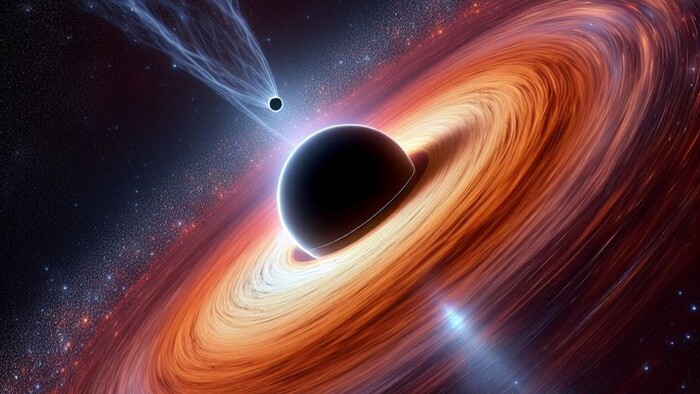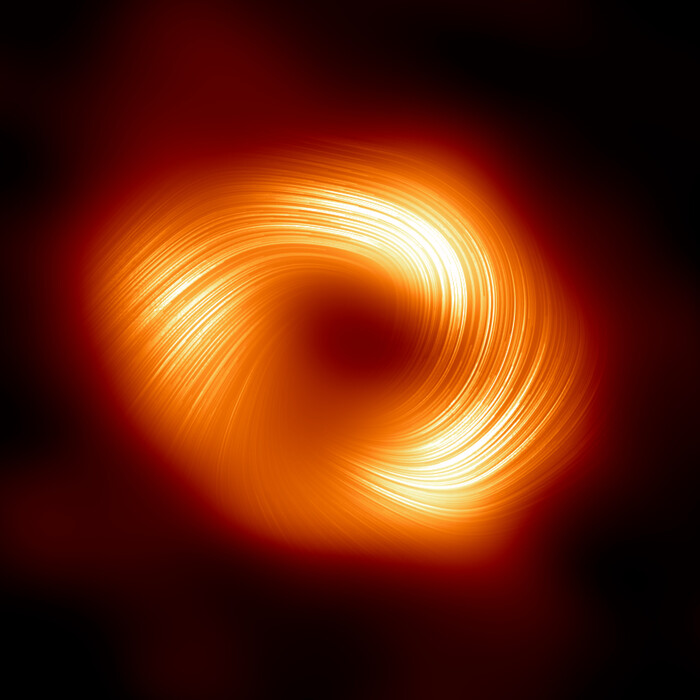Almost invisible: Researchers succeed in observing a rogue black hole for the first time
Created: 02/24/2022, 17:23
By: Tanya Banner
Black holes are fascinating celestial bodies.
Researchers have now discovered an isolated stellar black hole for the first time.
(Artistic representation) © Imago/blickwinkel
A rogue black hole is almost invisible – but researchers dug deep into their bag of tricks to observe such a celestial body for the first time.
Baltimore – Black holes are fascinating celestial bodies that come in different varieties: Supermassive black holes can weigh several billion solar masses and can be found at the center of most galaxies – this also applies to the Milky Way*.
Stellar black holes, on the other hand, form when stars about 20 times the mass of our Sun collapse at the end of their lives.
This usually happens during a supernova.
Then a stellar black hole is formed that has several solar masses, i.e. is significantly smaller and lighter than a supermassive black hole.
Because black holes absorb light but don't let it out, they are extremely difficult to detect.
That is why all stellar black holes known so far have a companion, for example a neutron star.
Their interaction with the star makes them easier to spot.
But there should be about 100 million stellar black holes in the Milky Way* alone, and most of them should be loners, says astrophysicist Kailash Sahu of the Space Telescope Science Institute in Baltimore.
"No one has ever been able to find an isolated black hole," Sahu told Space.com.
Free-Flying Black Hole Observed for First Time – “Now Know They Exist”
But now researchers around Sahu have apparently succeeded for the first time in observing a rogue black hole.
The study was published on the preprint server arXiv, has not yet been reviewed by experts, but has been submitted for publication in the Astrophysical Journal.
Accessing the Hubble Space Telescope for the study, the research team discovered a free-flying stellar hole 5,150 light-years from Earth.
"We now know that isolated black holes exist," says Sahu.
To track down the free-flying black hole, the researchers used a phenomenon called "gravitational lensing".
This effect occurs because large masses - such as a black hole - deflect light through their gravity.
So if an almost invisible black hole passes in front of a star, the star's light is influenced by this "lens".
"If you can detect and measure the diffraction of light caused by these massive objects, it is possible to track them down and measure their mass," explains Sahu, explaining his team's approach.
Gravitational lensing reveals the isolated black hole
Several ground-based sky-monitoring programs look out for these gravitational lensing effects each night, where a star slowly brightens over months and then fades again.
According to Sahu, about 2000 of these effects are discovered every year, but in addition to black holes, other celestial bodies - such as white dwarfs or neutron stars - can also be triggers.
Because black holes are large, however, it is assumed that the microlensing effect lasts for a long time.
Also, the lens itself shouldn't emit light, since black holes don't.
"If the 'Hubble' observations show strong deflection but no light from the lens, then it would be a black hole," explains Sahu.
To discover the first isolated stellar black hole - a black hole that was ejected in the process of formation and has no companion - the researchers combined Hubble data and Earth-based observations.
In doing so, they discovered a microlensing event that lasted for 270 days - most likely the free-flying black hole.
"It took two years of planning, followed by six years of observations with Hubble, but it was very gratifying to see the amazing result," Space.com quoted the study's lead author Sahu.
Type | stellar black hole |
|---|---|
distance to earth | 5150 light years |
Dimensions | 7.1 solar masses |
speed | 162,000km/h |
Isolated black hole moves at 100,000 miles per hour
The free-flying black hole has 7.1 solar masses and moves through space at a speed of about 162,000 kilometers per hour.
The black hole may have received a jolt from the supernova explosion that created it, and ejected it.
What's going on in the sky above our heads, which topics are astronomy concerned with and what is moving the space industry?
Subscribe to the free FR newsletter* and stay up to date!
Future observations with planned telescopes such as the Nancy Grace Roman Space Telescope or the Vera C. Rubin Telescope in Chila could help discover more stellar black holes, the research team believes.
The astrophysicist Sahu is certain of one thing: "There must be a lot of them out there." (tab)
*fr.de is an offer from IPPEN.MEDIA.





